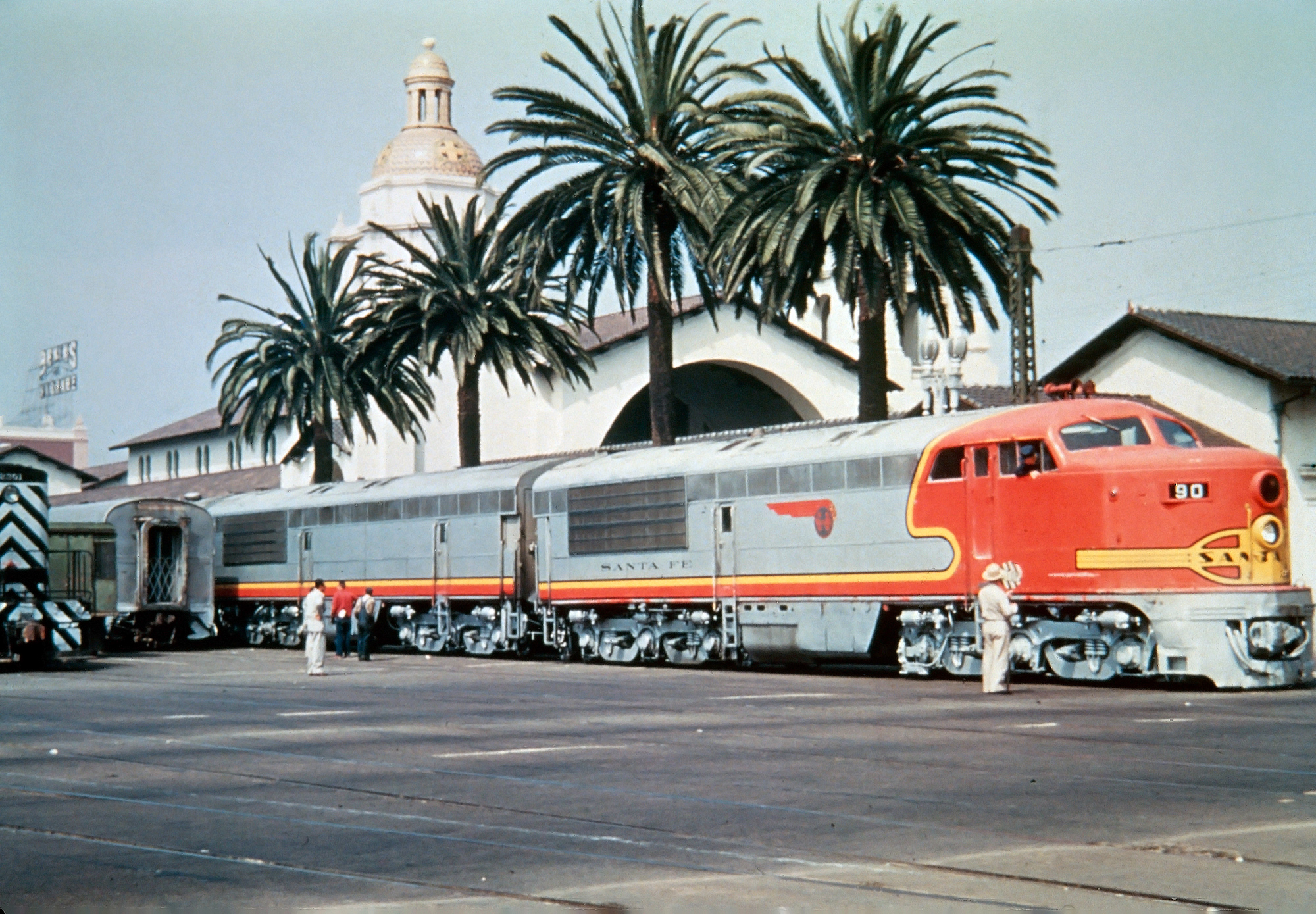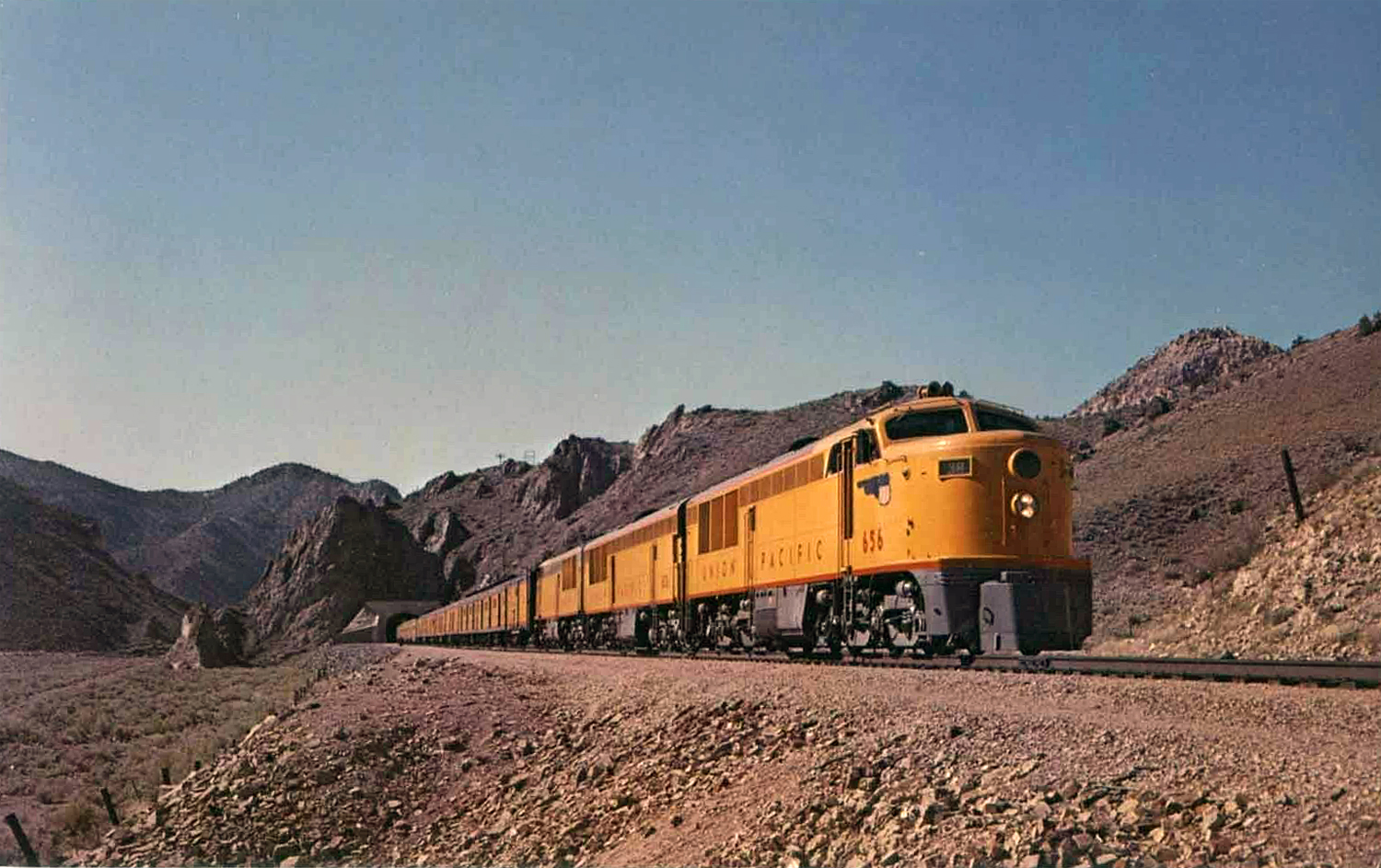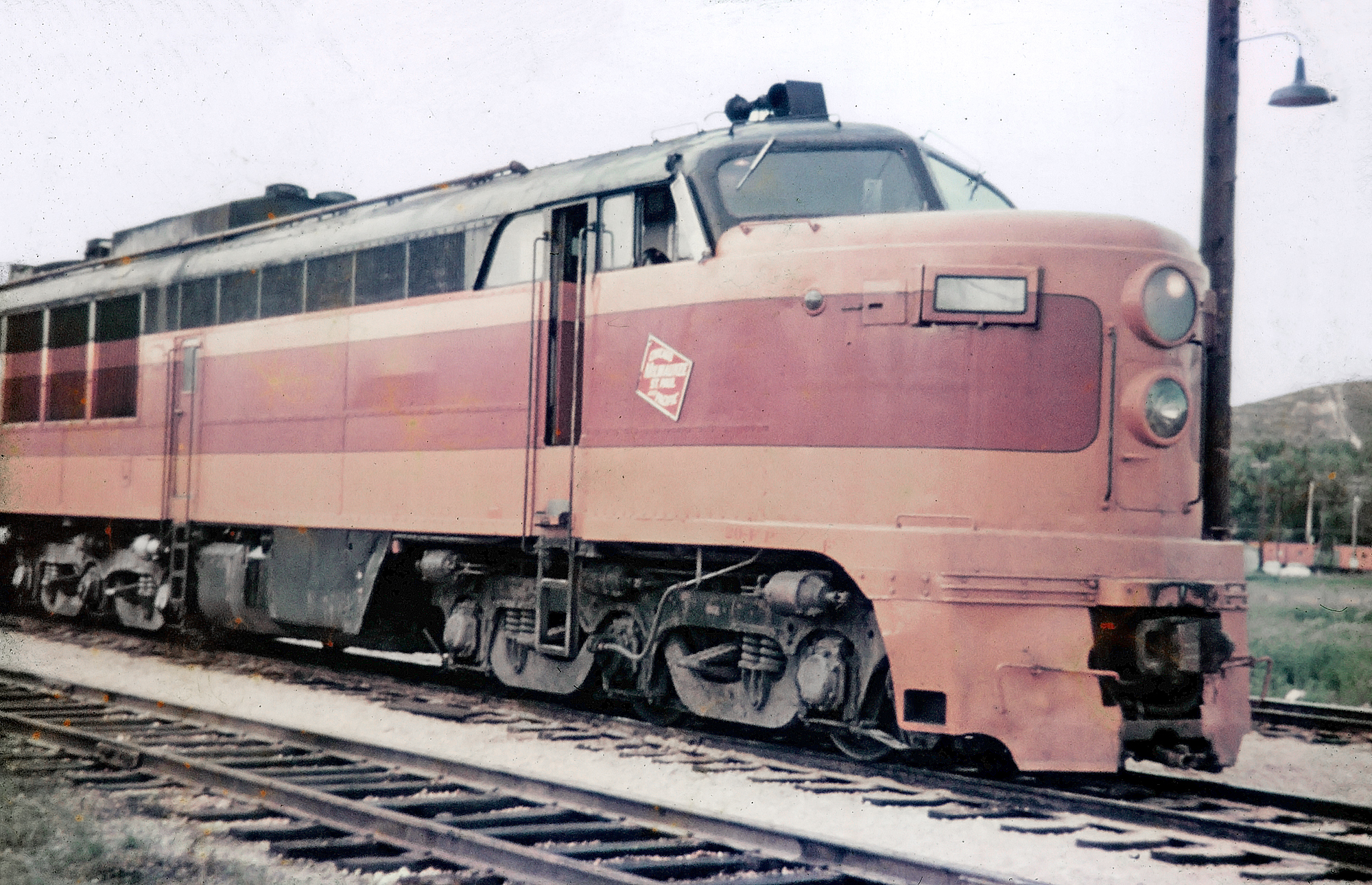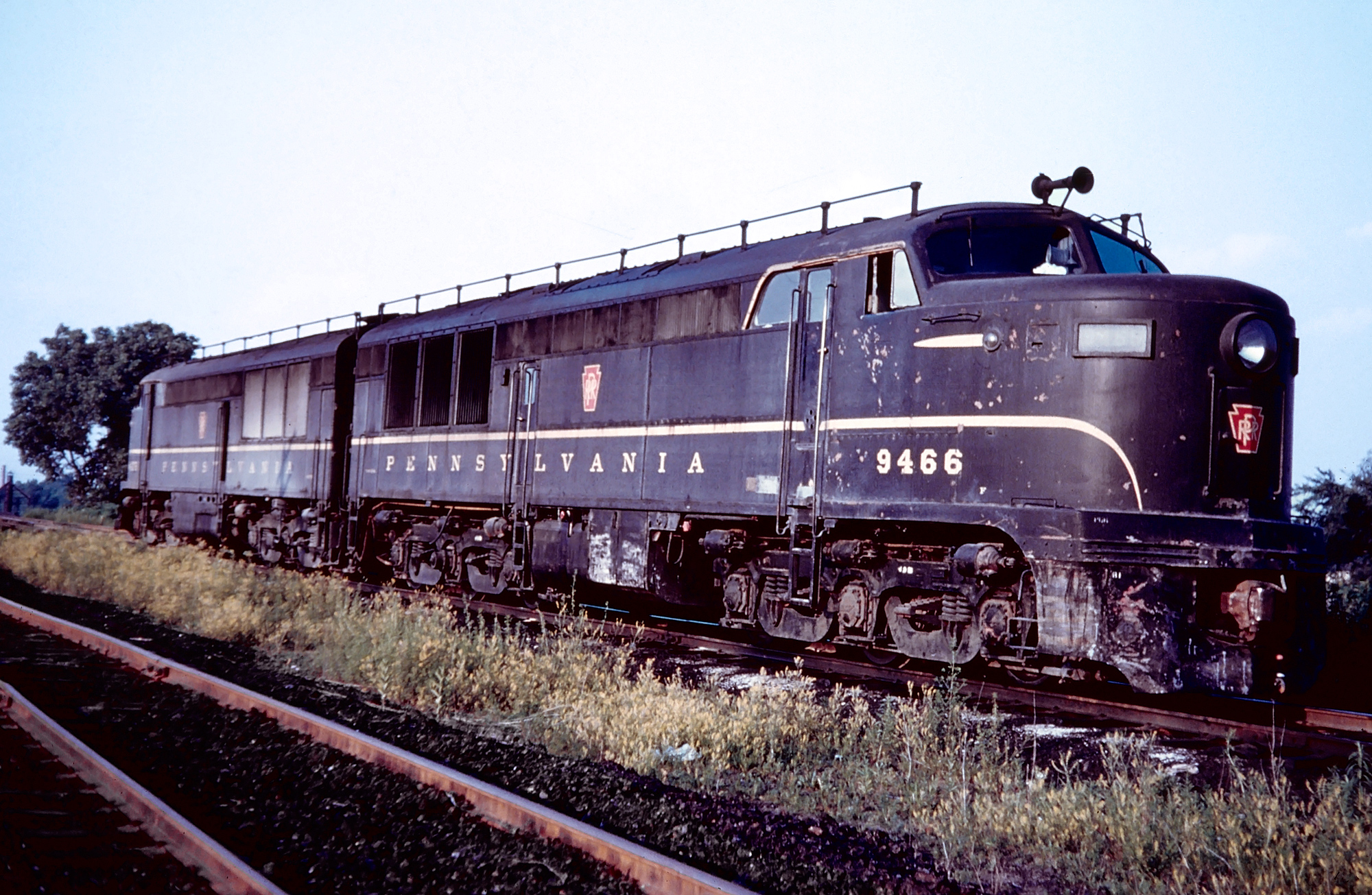FM "Erie-Built" Locomotives: Specs, Roster, History
Last revised: December 16, 2024
By: Adam Burns
The Erie-Built's were Fairbanks Morse's first cab design it ever cataloged. While largely designed as a passenger model, aimed at competing against Electro-Motive's successful E series, the Erie's were also offered with freight gearing.
In addition, their looks rivaled Alco's beautiful PA design as well as EMD's E series. Fairbanks Morse worked incredibly hard to market a passenger model that could effectively hold its own against the leading manufacturers.
Incredibly, FM never really gave the locomotive a formal name; railfans coined the term "Erie Built" after FM elected to outsource manufacturing to General Electric at its Erie, Pennsylvania plant.
When the locomotives initially entered production in late 1945, FM did not have available capacity to build them. In an effort to keep up with the competition, company officials elected to utilize General Electric, as GE was also supplying internal electrical equipment (traction motors, generators, etc.)
Fairbanks Morse did make several initial sales with the Erie-Built but overall failed to truly compete against either EMD or Alco.
In an ironic twist, both FM and American Locomotive cataloged passenger models which were quite aesthetically pleasing, featuring a long nose, sloped windshield, and clean streamlining.
Unfortunately, neither could rival Electro-Motive's "E" series, which dominated the market until it was retired in the late 1950's.
Photos
 Santa Fe's only A-B-A set of "Erie-Builts" is seen here in front of the beautiful station at San Diego, California, circa 1950. American-Rails.com collection.
Santa Fe's only A-B-A set of "Erie-Builts" is seen here in front of the beautiful station at San Diego, California, circa 1950. American-Rails.com collection.Overview
Fairbanks Morse's cab models basically all carried a similar appearance, not unlike Alco's FA and PA. FM introduced its cab line in an effort to compete against Electro-Motive's highly successful E and F series.
The first of these was known simply as the "Erie-Built" because the carbody was manufactured by General Electric at its Erie, Pennsylvania plant.
In 1950, however, the company introduced a formal line of passenger units known as the “Consolidated Line,” commonly referred today as C-Liners. These later models were available in three different variations; 1,600, 2,000, and 2,400 horsepower.
The Erie-Builts began production in December of 1945; they featured a look somewhat similar to the PA with a long, graceful nose followed by a sweeping, streamlined body behind the cab. Overall, it was a very classy and elegant locomotive.
The Erie-Builts utilized A1A-A1A trucks and produced a hearty 2,000 horsepower, equipped with the builder's 2-cycle 38D8 1/8, 10-cylinder opposed-piston prime mover.
 In this Union Pacific publicity photo an A-B-A set of "Erie Builts" have the eastbound "Pony Express" in Nevada's Rainbow Canyon south of Caliente, circa 1955.
In this Union Pacific publicity photo an A-B-A set of "Erie Builts" have the eastbound "Pony Express" in Nevada's Rainbow Canyon south of Caliente, circa 1955.The locomotive's continuous tractive effort ranged from 26,200 to 41,000 pounds depending on the gear ratio chosen. Aesthetically, some of the best remembered Erie-Builts were those constructed for the Milwaukee Road.
Manufactured between December of 1945 and March of 1947 the locomotives powered the famous Olympian Hiawatha between Chicago and the Pacific Coast at Seattle.
They were clad in Milwaukee’s beautiful two-tone red/orange livery with chrome plating around the nose with Olympian Hiawatha included just under each side the cab.
It was a very graceful, albeit brief look. Surprisingly, the Erie-Builts sold relatively well (by Fairbanks Morse standards anyway) with 111 units outshopped by the time the builder had ceased construction in April of 1949.
 Milwaukee Road "Erie-Built" #9-A (outshopped in March, 1947) is seen here in Council Bluffs, Iowa during July, 1957. The railroad was never particularly fond of these locomotives and they were traded in to EMD in the early 1960s. Fred Byerly photo. American-Rails.com collection.
Milwaukee Road "Erie-Built" #9-A (outshopped in March, 1947) is seen here in Council Bluffs, Iowa during July, 1957. The railroad was never particularly fond of these locomotives and they were traded in to EMD in the early 1960s. Fred Byerly photo. American-Rails.com collection.In all, seven Class Is purchased the diesel including the Santa Fe, Chicago & North Western, Milwaukee Road, New York Central, Kansas City Southern, Pennsylvania, and Union Pacific. The Canadian roads never purchased the model although the Canadian National and Canadian Pacific did purchase the C-Liner.
Data Sheet and Specifications
| Entered Production | 12/1945 (Fairbanks-Morse A-B-A Demonstrators*) |
| Years Produced | 12/1945 - 9/1949 |
| Fairbanks-Morse Class | None |
| Engine | 38D8 1/8, 10-cylinder Opposed-Piston |
| Engine Builder | Fairbanks-Morse |
| Horsepower | 2000 |
| RPM | 850 |
| Length (Inside Couplers) | 64' 10" (194' 6" In A-B-A Configuration) |
| Height (Top Of Rail To Top Of Cab) | 15' 1" |
| Width | 10' 6" |
| Weight (Passenger Units) | 328,000 Lbs |
| Weight (Freight Units) | 314,000 Lbs |
| Trucks | A1A-A1A |
| Truck Type | GSC Swing Bolster, Drop Side Equalizer |
| Truck Wheelbase | 15' 5" |
| Wheel Size | 40" (42" Optional) |
| Steam Generator (Passenger Units Only) | 2,250 Lb/Hour, 1,170 Gallon Supply |
| Traction Motors | GE746 (4), GE |
| Traction Generator | GT567, GE |
| Auxiliary Generator | AM807, GE |
| MU (Multiple-Unit) | Yes |
| Dynamic Brakes | Optional |
| Gear Ratio (Freight) | See Table Below |
| Tractive Effort (Freight) | See Table Below |
| Top Speed (Freight) | See Table Below |
| Gear Ratio (Passenger) | See Table Below |
| Tractive Effort (Passenger) | See Table Below |
| Top Speed (Passenger) | See Table Below |
* This A-B-A set became Union Pacific 50-M-1A, 50-M-3B, 50-M-2A. They were soon renumbered as 981A, 983B, and 982A.
Gearing Options
(Freight Units)
| Gear Ratio | Wheel Diameter | Maximum Speed | Continuous Tractive Effort (Lbs) | Continuous TE Rating Speed (MPH) |
|---|---|---|---|---|
| 68:19 | 40" | 75 | 37,400 | 17 |
| 70:17 | 42" | 68 | 41,000 | 15 |
(Passenger Units)
| Gear Ratio | Wheel Diameter | Maximum Speed | Continuous Tractive Effort (Lbs) | Continuous TE Rating Speed (MPH) |
|---|---|---|---|---|
| 63:24 | 40" | 102 | 27,400 | 23 |
| 63:24 | 42" | 107 | 26,200 | 24 |
Production Rosters
Passenger Units
Total Built = 46
| Owner | Road Number | Construction Number | Contract Number | Completion Date | Quantity |
|---|---|---|---|---|---|
| Union Pacific | 50-M-1A | L1060 | LD6 | 12/1945 | 1 |
| Union Pacific | 50-M-2A | L1061 | LD6 | 12/1945 | 1 |
| Union Pacific | 50-M-3B (B) | L1062 | LD6 | 12/1945 | 1 |
| Milwaukee Road | 5A | L1063 | LD8 | 10/1946 | 1 |
| Milwaukee Road | 5B (B) | L1064 | LD8 | 10/1946 | 1 |
| Milwaukee Road | 5C | L1065 | LD8 | 10/1946 | 1 |
| Milwaukee Road | 6A | L1066 | LD8 | 1/1947 | 1 |
| Milwaukee Road | 6B (B) | L1067 | LD8 | 1/1947 | 1 |
| Milwaukee Road | 6C | L1068 | LD8 | 1/1947 | 1 |
| Milwaukee Road | 7A | L1069 | LD8 | 1/1947 | 1 |
| Milwaukee Road | 7B (B) | L1070 | LD8 | 1/1947 | 1 |
| Milwaukee Road | 7C | L1071 | LD8 | 1/1947 | 1 |
| Milwaukee Road | 8A | L1072 | LD8 | 1/1947 | 1 |
| Milwaukee Road | 8B (B) | L1073 | LD8 | 1/1947 | 1 |
| Milwaukee Road | 8C | L1074 | LD8 | 1/1947 | 1 |
| Milwaukee Road | 9A | L1075 | LD8 | 3/1947 | 1 |
| Milwaukee Road | 9B (B) | L1076 | LD8 | 3/1947 | 1 |
| Milwaukee Road | 9C | L1077 | LD8 | 3/1947 | 1 |
| Chicago & North Western (CStPM&O) | 6001-A | L1090 | LD12 | 6/1947 | 1 |
| Chicago & North Western (CStPM&O) | 6001-B | L1092 | LD12 | 6/1947 | 1 |
| Chicago & North Western (CStPM&O) | 6002-A | L1093 | LD12 | 5/1947 | 1 |
| Chicago & North Western (CStPM&O) | 6002-B | L1095 | LD12 | 5/1947 | 1 |
| Santa Fe | 90 | L1099 | LD9 | 5/1947 | 1 |
| Santa Fe | 90A (B) | L1100 | LD9 | 5/1947 | 1 |
| Santa Fe | 90B | L1101 | LD9 | 5/1947 | 1 |
| Milwaukee Road | 22A | L1102 | LD20 | 8/1947 | 1 |
| Milwaukee Road | 22B | L1104 | LD20 | 8/1947 | 1 |
| Union Pacific | 984A-985A | L1117-L118 | LD28 | 6/1947 | 2 |
| Milwaukee Road | 21A, 21C | L1119-L120 | LD20 | 8/1947 | 2 |
| Union Pacific | 986B-987B (B) | L1127-L1128 | LD28 | 10/1947 | 2 |
| Union Pacific | 704-706 | L1136-L1138 | LD34 | 3/1948 | 3 |
| Union Pacific | 707 | L1139 | LD34 | 4/1948 | 1 |
| Union Pacific | 706B (B) | L1140 | LD34 | 4/1948 | 1 |
| Union Pacific | 21B (B) | L1157 | LD41 | 4/1948 | 1 |
| New York Central | 4400-4403 | L1177-L1180 | LD47 | 3/1949 | 4 |
| New York Central | 4404-4405 | L1181-L1182 | LD47 | 4/1949 | 2 |
Freight Units
Total Built = 65
| Owner | Road Number | Construction Number | Contract Number | Completion Date | Quantity |
|---|---|---|---|---|---|
| Kansas City Southern (Louisiana & Arkansas) | 60A | L1087 | LD11 | 11/1946 | 1 |
| Kansas City Southern (Louisiana & Arkansas) | 60B (B) | L1088 | LD11 | 11/1946 | 1 |
| Kansas City Southern (Louisiana & Arkansas) | 61A | L1089 | LD11 | 11/1946 | 1 |
| Kansas City Southern | 61B (B) | L1091 | LD11 | 11/1946 | 1 |
| Kansas City Southern | 60C | L1094 | LD16 | 1/1947 | 1 |
| Kansas City Southern (Louisiana & Arkansas) | 61C | L1096 | LD16 | 1/1947 | 1 |
| Kansas City Southern (Louisiana & Arkansas) | 62C, 62A | L1097-L1098 | LD22 | 6/1947 | 2 |
| Pennsylvania | 9456B (B) | L1103 | LD29 | 11/1947 | 1 |
| New York Central | 5000 | L1105 | LD19 | 10/1947 | 1 |
| Pennsylvania | 9458B (B) | L1106 | LD29 | 11/1947 | 1 |
| New York Central | 5001 | L1107 | LD19 | 10/1947 | 1 |
| Pennsylvania | 9456A | L1108 | LD29 | 11/1947 | 1 |
| Pennsylvania | 9460B (B) | L1109 | LD29 | 11/1947 | 1 |
| Pennsylvania | 9457A | L1110 | LD29 | 11/1947 | 1 |
| Pennsylvania | 9458A | L1111 | LD29 | 12/1947 | 1 |
| Pennsylvania | 9462B (B) | L1112 | LD29 | 11/1947 | 1 |
| Pennsylvania | 9459A | L1113 | LD29 | 12/1947 | 1 |
| Pennsylvania | 9460A | L1114 | LD29 | 1/1948 | 1 |
| Pennsylvania | 9464B (B) | L1115 | LD29 | 12/1947 | 1 |
| Pennsylvania | 9461A | L1116 | LD29 | 1/1948 | 1 |
| Pennsylvania | 9462A-9463A | L1121-L1122 | LD29 | 1/1948 | 2 |
| Pennsylvania | 9464A-9465A | L1123-L1124 | LD29 | 2/1948 | 2 |
| Pennsylvania | 9466B, 9468B (B) | L1125-L1126 | LD29 | 12/1947 | 2 |
| Pennsylvania | 9470B (B) | L1129 | LD29 | 12/1947 | 1 |
| Pennsylvania | 9466A-9468A | L1130-L1132 | LD29 | 2/1948 | 3 |
| Pennsylvania | 9469A | L1133 | LD29 | 3/1948 | 1 |
| Pennsylvania | 9470A | L1134 | LD29 | 2/1948 | 1 |
| Pennsylvania | 9471A | L1135 | LD29 | 3/1948 | 1 |
| Pennsylvania | 9472A-9473A | L1140-L1141 | LD35 | 6/1948 | 2 |
| Pennsylvania | 9476B (B) | L1144 | LD35 | 7/1948 | 1 |
| Kansas City Southern (Louisiana & Arkansas) | 62B (B) | L1145 | LD49 | 4/1948 | 1 |
| Pennsylvania | 9472B, 9474B (B) | L1146-L1147 | LD35 | 6/1948 | 2 |
| Pennsylvania | 9474A-9475A | L1148-L1149 | LD35 | 6/1948 | 2 |
| Pennsylvania | 9476A-9477A | L1150-L1151 | LD35 | 7/1948 | 2 |
| Pennsylvania | 9478A-9479A | L1152-L1153 | LD35 | 9/1948 | 2 |
| Pennsylvania | 9480A-9481A | L1154-L1155 | LD45 | 10/1948 | 2 |
| Pennsylvania | 9482A | L1156 | LD45 | 12/1948 | 1 |
| Pennsylvania | 9478B (B) | L1158 | LD35 | 9/1948 | 1 |
| New York Central | 5100 | L1159 | LD46 | 12/1948 | 1 |
| New York Central | 5101 | L1160 | LD46 | 1/1949 | 1 |
| Pennsylvania | 9483A | L1161 | LD45 | 11/1948 | 1 |
| Pennsylvania | 9484A-9487A | L1162-L1165 | LD45 | 10/1948 | 4 |
| Pennsylvania | 9488A-9490A | L1166-L1168 | LD45 | 12/1948 | 3 |
| Pennsylvania | 9491A | L1169 | LD45 | 12/1948 | 1 |
| New York Central | 5002 | L1170 | LD46 | 12/1948 | 1 |
| New York Central | 5003 | L1174 | LD46 | 1/1949 | 1 |
| New York Central | 5004-5005 | L1175-L1176 | LD46 | 2/1949 | 2 |
 A pair of Pennsylvania's Erie-Builts, with #9466 pictured (Class FF-20), is seen here at Toledo, Ohio in August, 1964. Fred Byerly photo. American-Rails.com collection.
A pair of Pennsylvania's Erie-Builts, with #9466 pictured (Class FF-20), is seen here at Toledo, Ohio in August, 1964. Fred Byerly photo. American-Rails.com collection.The later C-Liners were a bit unorthodox as passenger locomotives with an odd B-A1A truck arrangement resulting in very few railroads purchasing it.
The freight model, offered in a range of horsepower ratings, did a little better but in the end, FM gave up on the cab design altogether by 1953.
Today, no Erie-Builts are known to survive. Interestingly, a piece of this unique model lives on in Doyle McCormack's restored Alco PA #190.
The unit's trucks (designed by General Steel Castings) were salvaged for the restoration as they came from a scrapped Erie-Built, which had been converted for use by the Canadian Pacific in rail trains to lay continuous welded rail (CWR).
Recent Articles
-
Ferrocarriles Nacionales de México (N de M)
Jan 04, 26 11:52 PM
For much of the twentieth century, Ferrocarriles Nacionales de México—better known by its classic initials N de M, and later as FNM/Ferronales—served the heart of Mexico. -
Missouri Dinner Train Rides In Branson!
Jan 04, 26 07:00 PM
Nestled in the heart of the Ozarks, the Branson Scenic Railway offers one of the most distinctive rail experiences in the Midwest—pairing classic passenger railroading with sweeping mountain scenery a… -
Indiana Dinner Train Rides In Jasper
Jan 04, 26 06:32 PM
In the rolling hills of southern Indiana, the Spirit of Jasper offers one of those rare attractions that feels equal parts throwback and treat-yourself night out: a classic excursion train paired with…
Sources
- Kirkland, John F. Diesel Builders, The: Fairbanks-Morse And Lima-Hamilton. Glendale: Interurban Press, 1985.
- Pinkepank, Jerry A. Diesel Spotter's Guide. Milwaukee: Kalmbach Publishing Company, 1967.
- Schafer, Mike. Vintage Diesel Locomotives. Osceola: MBI Publishing, 1998.



